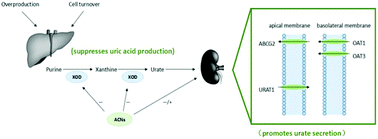当前位置:
X-MOL 学术
›
Food Funct.
›
论文详情
Our official English website, www.x-mol.net, welcomes your
feedback! (Note: you will need to create a separate account there.)
Hypouricemic and nephroprotective roles of anthocyanins in hyperuricemic mice†
Food & Function ( IF 5.1 ) Pub Date : 2019-01-18 00:00:00 , DOI: 10.1039/c8fo02124d Xiaoyun Qian 1, 2, 3, 4, 5 , Xu Wang 1, 2, 3, 4, 5 , Jing Luo 1, 2, 3, 4, 5 , Yao Liu 1, 2, 3, 4, 5 , Juan Pang 4, 5, 6, 7 , Hanyue Zhang 4, 5, 6, 7 , Zhongliang Xu 4, 5, 6, 7 , Jiewen Xie 4, 5, 6, 7 , Xinwei Jiang 4, 5, 8, 9, 10 , Wenhua Ling 1, 2, 3, 4, 5
Food & Function ( IF 5.1 ) Pub Date : 2019-01-18 00:00:00 , DOI: 10.1039/c8fo02124d Xiaoyun Qian 1, 2, 3, 4, 5 , Xu Wang 1, 2, 3, 4, 5 , Jing Luo 1, 2, 3, 4, 5 , Yao Liu 1, 2, 3, 4, 5 , Juan Pang 4, 5, 6, 7 , Hanyue Zhang 4, 5, 6, 7 , Zhongliang Xu 4, 5, 6, 7 , Jiewen Xie 4, 5, 6, 7 , Xinwei Jiang 4, 5, 8, 9, 10 , Wenhua Ling 1, 2, 3, 4, 5
Affiliation

|
Hyperuricemia (HUA) is a universal metabolic disorder characterized by a high level of uric acid in the serum. Anthocyanins (ACNs) are a group of natural flavonoids that have shown favourable bioactivities in the metabolic syndrome but the effect on uric acid metabolism remains underexplored. The present study investigated the hypouricemic effects of ACNs in a mice model and further studied the potential mechanisms. ICR mice based on a high-yeast diet were administered potassium oxonate (PO, 280 mg per kg body weight) and inosine (400 mg per kg body weight) to induce a hyperuricemia model, meanwhile, ACNs were supplemented by gavage. The mice were sacrificed after 3 weeks of treatment. ACN administration significantly reduced serum uric acid (SUA), blood urea nitrogen (BUN) and serum creatinine (Scr) levels and suppressed xanthine oxidase (XOD) activity in mice serum and liver. In addition, ACNs down-regulated the expression of hepatic XOD, caspase-1, tumor necrosis factor-α (TNF-α) and interleukin-1β (IL-1β) and regulated the expression of renal urate transporters URAT1, GLUT9, ABCG2, OAT1, OAT3, OCT1, OCT2, OCTN1 and OCTN2. According to histological analysis, ACN treatment exhibited hepatoprotective and nephroprotective effects in hyperuricemic mice. In conclusion, ACNs reduced urate production and promoted uric acid excretion from the renal system, which suggests the potential of ACNs for the future treatment of HUA.
中文翻译:

花青素在高尿酸血症小鼠中的低血钾和肾保护作用†
高尿酸血症(HUA)是一种普遍的代谢性疾病,其特征是血清中尿酸水平较高。花青素(ACN)是一组天然类黄酮,在代谢综合症中显示出良好的生物活性,但对尿酸代谢的影响仍未得到充分研究。本研究调查了小鼠模型中ACN的降尿酸作用,并进一步研究了其潜在机制。以高酵母饮食为基础的ICR小鼠接受草酸钾(PO,280 mg / kg体重)和肌苷(400 mg / kg体重)诱发高尿酸血症模型,同时通过强饲法补充ACNs。治疗3周后处死小鼠。ACN给药可显着降低血清尿酸(SUA),小鼠血清和肝脏中的血尿素氮(BUN)和血清肌酐(Scr)水平并抑制了黄嘌呤氧化酶(XOD)活性。此外,ACN下调肝XOD,caspase-1,肿瘤坏死因子-α(TNF-α)和白介素-1β(IL-1β)的表达,并调节肾尿酸转运蛋白URAT1,GLUT9,ABCG2, OAT1,OAT3,OCT1,OCT2,OCTN1和OCTN2。根据组织学分析,ACN处理在高尿酸血症小鼠中表现出肝保护和肾保护作用。总之,ACNs减少尿酸盐的产生并促进肾脏系统中尿酸的排泄,这表明ACNs在将来治疗HUA方面的潜力。肿瘤坏死因子-α(TNF-α)和白细胞介素-1β(IL-1β)并调节肾尿酸转运蛋白URAT1,GLUT9,ABCG2,OAT1,OAT3,OCT1,OCT2,OCTN1和OCTN2的表达。根据组织学分析,ACN处理在高尿酸血症小鼠中表现出肝保护和肾保护作用。总之,ACNs减少尿酸盐的产生并促进肾脏系统中尿酸的排泄,这表明ACNs在将来治疗HUA方面的潜力。肿瘤坏死因子-α(TNF-α)和白细胞介素-1β(IL-1β)并调节肾尿酸转运蛋白URAT1,GLUT9,ABCG2,OAT1,OAT3,OCT1,OCT2,OCTN1和OCTN2的表达。根据组织学分析,ACN处理在高尿酸血症小鼠中表现出肝保护和肾保护作用。总之,ACNs减少尿酸盐的产生并促进肾脏系统中尿酸的排泄,这表明ACNs在将来治疗HUA方面的潜力。
更新日期:2019-01-18
中文翻译:

花青素在高尿酸血症小鼠中的低血钾和肾保护作用†
高尿酸血症(HUA)是一种普遍的代谢性疾病,其特征是血清中尿酸水平较高。花青素(ACN)是一组天然类黄酮,在代谢综合症中显示出良好的生物活性,但对尿酸代谢的影响仍未得到充分研究。本研究调查了小鼠模型中ACN的降尿酸作用,并进一步研究了其潜在机制。以高酵母饮食为基础的ICR小鼠接受草酸钾(PO,280 mg / kg体重)和肌苷(400 mg / kg体重)诱发高尿酸血症模型,同时通过强饲法补充ACNs。治疗3周后处死小鼠。ACN给药可显着降低血清尿酸(SUA),小鼠血清和肝脏中的血尿素氮(BUN)和血清肌酐(Scr)水平并抑制了黄嘌呤氧化酶(XOD)活性。此外,ACN下调肝XOD,caspase-1,肿瘤坏死因子-α(TNF-α)和白介素-1β(IL-1β)的表达,并调节肾尿酸转运蛋白URAT1,GLUT9,ABCG2, OAT1,OAT3,OCT1,OCT2,OCTN1和OCTN2。根据组织学分析,ACN处理在高尿酸血症小鼠中表现出肝保护和肾保护作用。总之,ACNs减少尿酸盐的产生并促进肾脏系统中尿酸的排泄,这表明ACNs在将来治疗HUA方面的潜力。肿瘤坏死因子-α(TNF-α)和白细胞介素-1β(IL-1β)并调节肾尿酸转运蛋白URAT1,GLUT9,ABCG2,OAT1,OAT3,OCT1,OCT2,OCTN1和OCTN2的表达。根据组织学分析,ACN处理在高尿酸血症小鼠中表现出肝保护和肾保护作用。总之,ACNs减少尿酸盐的产生并促进肾脏系统中尿酸的排泄,这表明ACNs在将来治疗HUA方面的潜力。肿瘤坏死因子-α(TNF-α)和白细胞介素-1β(IL-1β)并调节肾尿酸转运蛋白URAT1,GLUT9,ABCG2,OAT1,OAT3,OCT1,OCT2,OCTN1和OCTN2的表达。根据组织学分析,ACN处理在高尿酸血症小鼠中表现出肝保护和肾保护作用。总之,ACNs减少尿酸盐的产生并促进肾脏系统中尿酸的排泄,这表明ACNs在将来治疗HUA方面的潜力。











































 京公网安备 11010802027423号
京公网安备 11010802027423号